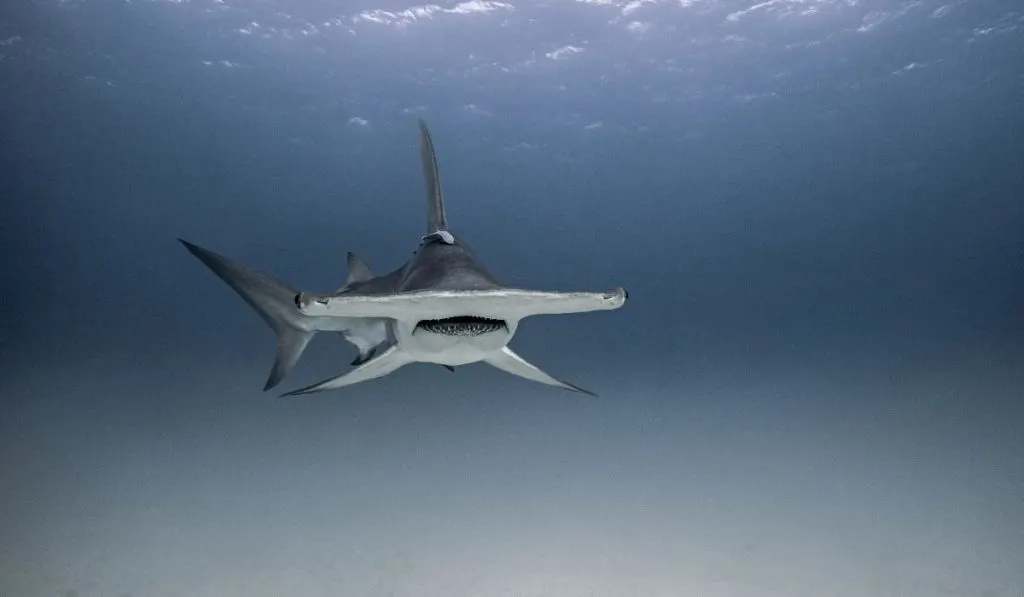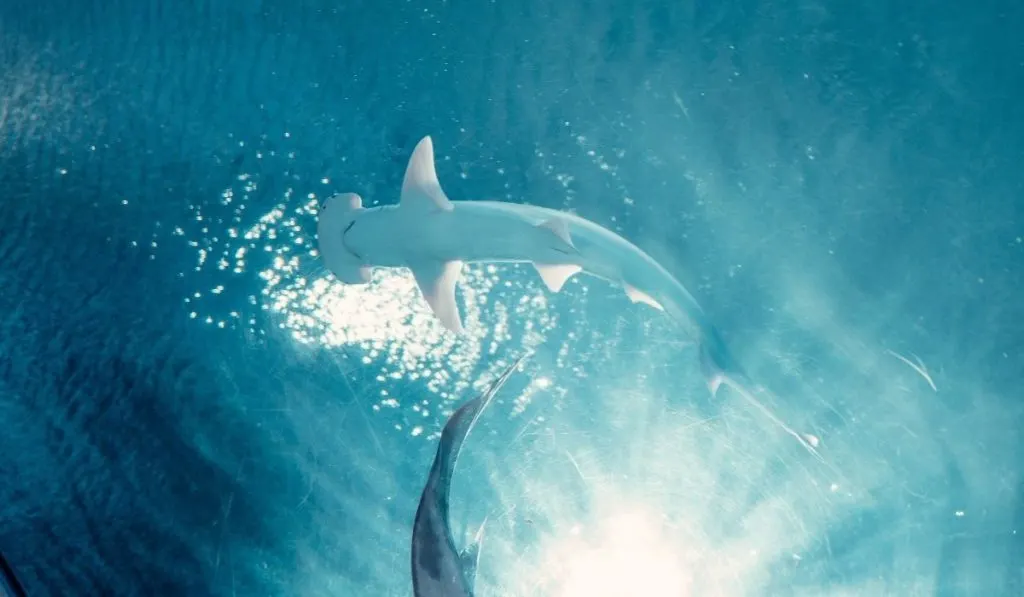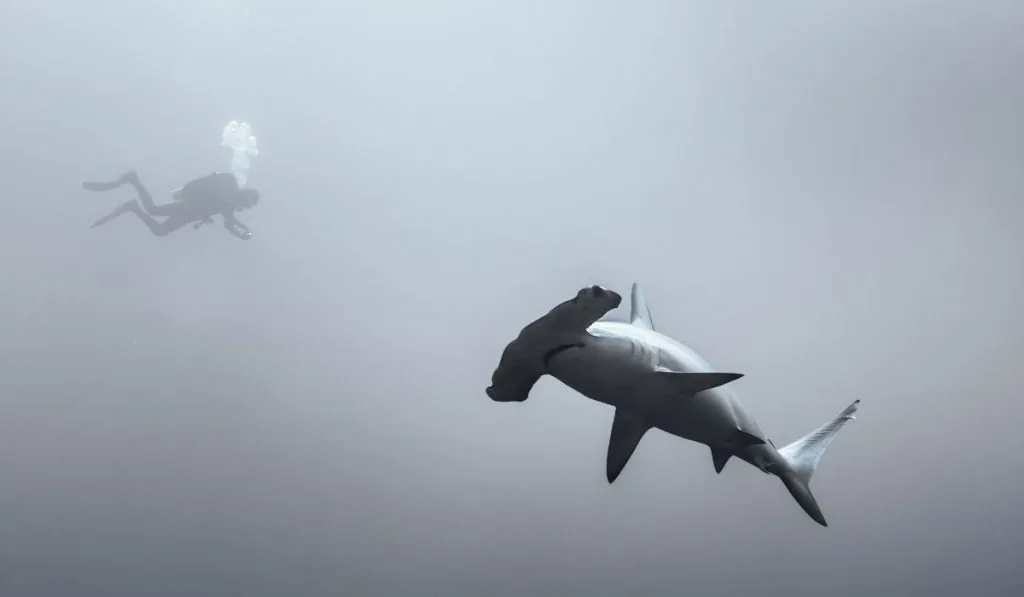Located around six hundred miles from continental Ecuador, the Galapagos Islands are well-known for many of their natural treasures.
This group of volcanic islands is rich in flora and fauna. The archipelago stretches to about 17,000 square miles (or 45,000 square kilometers) and consists of 19 islands and dozens of islets.
Without too many natural predators, you can expect to witness all kinds of wildlife around the islands and also in the deep sea.
Some of the most unique and amazing creatures that you can find in the Galapagos are hammerhead sharks.
Hammerheads can be recognized instantly by their distinctive hammer-shaped head. This unusual part of their head is called cephalofoil and acts as a scanner that gives them depth perception and sharp, binocular vision.
However, can we see these sharks every day in the sea surrounding the Galapagos? When is the best time to see hammerheads in Galapagos?
The best time to see hammerhead sharks in the Galapagos would be from December to early May. During this period, the weather is good enough for you to watch these sharks swim right next to you without having to worry about high tide or rainy days.
You can scuba dive or snorkel around specific areas where the hammerheads spend their day. Additionally, the temperature of the water is much warmer, which is between 68°F and 77°F, and the surrounding air temperature fluctuates between 85°F and 95°F.
Basically, there are two diving seasons in Galapagos. One is during the wet season (which is from December to May), and the other is during the dry season (which is from June to November).
Although liveaboards or dive charters offer cruises during these two seasons, you will have the best experience of watching hammerhead sharks in the wet season. There are also no seasonal winds during this period that can interfere with your diving activities.

What Species of Hammerheads Exist in the Galapagos
The most common species of hammerhead shark that you can find in the Galapagos is the scalloped hammerhead shark.
Scalloped hammerhead sharks measure between 13 and 19 feet long and weigh around 64 pounds. They frequently swim at a depth of 600 feet and can be seen flocking in large schools of hundreds or more.
You can only see adult sharks swim in the deep because most young hammerheads reside by the shallow waters along the shore to avoid predators.
Aside from their hammer-shaped heads, these sharks can be distinguished by their widely set eyes, large nostrils, and an arched edge at the front of their head. Most scalloped hammerheads are silvery-gray in color with faded-white coloration on the underside.
Out of all shark species, they have the largest brain that contributes to their sharp sensory perception, sensorimotor functions, and their predatory intelligence.
Although they are mostly found in large schools, some hammerheads are solitary and can be found swimming around rocky reefs and boulder-strewn slopes. Due to their docile nature, scalloped hammerheads aren’t dangerous to humans.

Where Can You See Hammerheads In Galapagos
There are two popular spots to watch hammerheads in Galapagos. They are Wolf Island and the northern Island of Darwin.
These two popular hammerheads islands can only be reached by liveaboards. So, expect to pay for the cruise charge and drift-divers fee that can help you to navigate the current during snorkeling or diving season.
At these islands, you can watch large schools of sharks of around 100 or more swimming beside you. Aside from these two spots, you can also watch hammerheads near Kicker Rock and the Hammerhead Shark Nursery located on the Santa Cruz Island of the Galapagos.

Tips for Diving with Hammerhead Sharks
Like most marine animals, scalloped hammerheads can be quite wary around humans, especially if you’re diving with a group of people. When you dive to watch these sharks, there are a few tips that you can follow to get close to these sharks. These include:
Swim Parallel to the Sharks
Avoid swimming directly at hammerheads to avoid startling them. Swimming parallel to the sharks is the best way to get close to them. In some cases, the bubbles coming out of your scuba equipment can make them skittish. Hence, be sure to approach hammerheads slowly and avoid any sudden movement.
Stay Still When They Get Close
When these sharks are comfortable enough to swim close to you, stay still and don’t spook them away. Try to remain as calm as you possibly can so they can sense that your presence is not a threat.
Swim Closely to the Reefs
When snorkeling or diving in Galapagos, you will see boulder substrate, volcanic rocks, and reefs that are filled with live corals. This magnificent marine ecosystem is what makes the Galapagos special to the hammerheads. To get close to the sharks, you can hide or stay close to the reef and watch them swim around the reef.
Take Care of the Marine Ecosystem
It goes without saying that taking care of the reef should always be on your priority list. If you intend to swim or get close to the reef, try not to touch the coral with your hands or swimming fins. You can have the best diving experience without interrupting marine life.
Have Patience When Taking Photos
If you ever decide to take photos of the scalloped hammerheads, do remember that taking photos underwater isn’t similar to taking photos on the ground. You should avoid moving your camera too fast, taking photos from blind spots, and using autofocus, especially when you take photos of these sharks swimming close to you.

What Makes Hammerheads Visit the Galapagos Islands
Scalloped hammerhead sharks are known to be coastal pelagic species. They can dive as deep as 1,000 feet and live in open oceans.
Most of the time, they will swim near the shallow water and feed on fish such as mackerel, herring, and sardine. Occasionally, they will also feed on squids, crustaceans, and stingrays in the deeper sea. Although the Galapagos Islands are rich with prey and food for the hammerheads, there are other reasons that make them appear on this archipelago.
For instance, these sharks visit the Galapagos to be cleaned by the king angelfish. These tropical angelfish are known to clean the hammerheads and feed on varieties of zooplankton and sponges.
Scalloped hammerheads also visit the Galapagos to breed with other female sharks. Generally, the males will mate with dominant females that swim in the center of the schools.
Final Thoughts
As one of the UNESCO World Heritage sites, the Galapagos Islands offer a lot of activities through the richness of their biodiversity.
Although you can witness hammerhead sharks swimming freely in other places, the marine ecosystem around these chains of islands has been preserved by the WWF (World Wide Fund for Nature). Hence, they aren’t disturbed by rapid modernization and are safely isolated for the sake of protecting their flora and fauna.
Plan your trip to the Galapagos, and experience these beautiful islands with your own eyes!
Citations
- https://galapagosinsiders.com/travel-blog/galapagos-hammerhead-shark/
- https://www.adventuresmithexplorations.com/trips/galapagos/when-to-travel-best-month/
- https://www.scubadivingearth.com/when-is-the-best-time-to-see-hammerheads-in-galapagos-islands/
- https://rove.me/to/galapagos/hammerheads-and-manta-season
- https://happygringo.com/blog/hammerhead-shark-galapagos/
- https://www.galapagossky.com/galapagos/diving-with-hammerheads/
